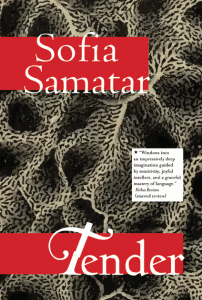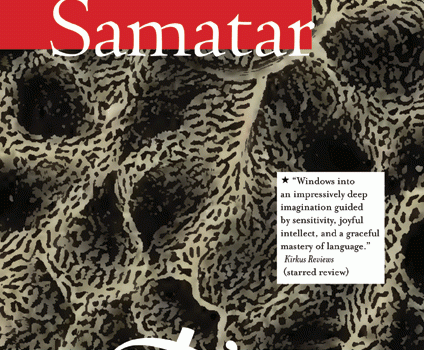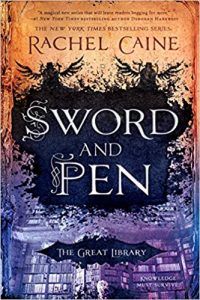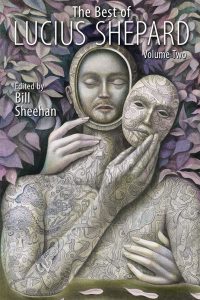Gary K. Wolfe reviews Tender: Stories by Sofia Samatar
Tender: Stories, Sofia Samatar (Small Beer 978-1-618-73126-5, $24.00, 280pp, hc) April 2017.
 The practice of including original stories in a collection of mostly reprints is usually an astute marketing decision, but perhaps not always the best literary decision. There have been cases, some in fairly recent memory, in which brilliant tales that helped establish the writer’s reputation are mixed with what one suspects were trunk stories that never found a market the first time out. I suspect we don’t have to worry about this with collections from Small Beer, though. Sofia Samatar’s Tender: Stories includes two excellent new pieces together with 18 reprints, and one of them, “Fallow”, is not only the longest story in the collection, but also her most complex and accomplished SF story to date. On the basis of her award-winning debut novel A Stranger in Olondria and its sequel The Winged Histories, Samatar’s reputation has been mostly that of a fantasist, and her most famous story, “Selkie Stories Are For Losers” (the lead selection here) seemed to confirm that reputation – although once Samatar establishes the parameters of her fantastic worlds, she works out both her plot details and cultural observations with the discipline of a seasoned SF writer and the psychological insight of a poet.
The practice of including original stories in a collection of mostly reprints is usually an astute marketing decision, but perhaps not always the best literary decision. There have been cases, some in fairly recent memory, in which brilliant tales that helped establish the writer’s reputation are mixed with what one suspects were trunk stories that never found a market the first time out. I suspect we don’t have to worry about this with collections from Small Beer, though. Sofia Samatar’s Tender: Stories includes two excellent new pieces together with 18 reprints, and one of them, “Fallow”, is not only the longest story in the collection, but also her most complex and accomplished SF story to date. On the basis of her award-winning debut novel A Stranger in Olondria and its sequel The Winged Histories, Samatar’s reputation has been mostly that of a fantasist, and her most famous story, “Selkie Stories Are For Losers” (the lead selection here) seemed to confirm that reputation – although once Samatar establishes the parameters of her fantastic worlds, she works out both her plot details and cultural observations with the discipline of a seasoned SF writer and the psychological insight of a poet.
So it’s not surprising that “Fallow” should present us with a richly textured world, although a fairly inhospitable one: a rocky world of windstorms and radioactive stones, to which the narrator’s people fled in a generation starship to escape both religious persecution and a rapidly deteriorating Earth, with its “bitter atmosphere and boiling seas, its floods, its storms, its wars and conflagrations.” In 500 years or so, they hope to return, but in the meantime they have established an almost feudal religious colony, with technology, medicine, and government centered in a Castle apart from the villagers, and the rare visiting Earthman (the term is used for both men and women) treated as potential hazards. More important, and perhaps more characteristic of Samatar, is how she reveals this world: the young narrator Agar recounts three stories of characters important in her life: the beloved and unorthodox teacher Miss Snowfall, the Young Evangelists agitator and self-appointed psychologist Brother Lookout, and Agar’s own older sister Temar, who has disappeared, leaving Agar a long letter recounting her own struggles with the culture of Fallow. One of Samatar’s favored techniques is to embed stories within stories, or to reveal stories incrementally through an ostensibly non-narrative form like a catalog, as in “Ogres of East Africa”, in which the young assistant researcher’s own travails gradually invade the list of supernatural beings, or the Borges-flavored faux-scholarly paper “A Brief History of Nonduality Studies”, an interview in “How I met the Ghoul”, or even a request for a contract extension from a lone orbiting space station worker in “Request for an Extension on the Clarity“.
The embedded story is only one of several techniques and themes that recur throughout the collection. It’s no accident that the first story Agar recounts involves a teacher, since the dynamic of teaching and learning shows up in much of her fiction, as it did in her two novels. Without resorting to the awkward second-person voice, Samatar finds ways to let us know that many of these narratives are directed at specific listeners, and a few even take on the venerable form of the epistolary tale, such as “Olimpia’s Ghost”, a variation on themes from E.T.A. Hoffmann’s “The Sandman”, or “The Red Thread”, which describes, through a series of unanswered letters, the narrator’s progress through a postapocalyptic world peppered by “isolation zones” (again, there is the teaching theme as the narrator’s mother sees teaching “as her way of giving thanks”). “Walkdog”, the funniest story here, even takes the form of a petulant student paper, complete with misspellings, digressions, and snarky asides to the teacher, though the fantasy element behind it is an intriguing sort of urban legend. Along with “Selkie Stories”, it demonstrates Samatar’s capacity for dead-on vernacular voices.
The collection is divided into two parts, “Tender Bodies” and “Tender Landscapes”, which are exactly what they sound like. “Tender” takes on a dual meaning, like “Request for an Extension on the Clarity”, the title story “Tender” involves a character whose job is literally to tend to equipment, in this case a remote “Radioactive Materials Containment Center.” Suffering from radiation exposure, the narrator also says, “I am so tender now, I feel the earth’s pain all through my body.” It’s one of the stronger SF stories in the book, along with “How to Get Back to the Forest”, set in a bizarre sort of summer camp in a world revealed to be increasingly dystopian, and “Honey Bear”, reminiscent of Carol Emshwiller’s classic “A Day at the Beach” in its account of a family apparently out for a beach holiday until we realize something very strange about the little girl and the “Fair Folk” who have invaded this world. Together with the remarkable new novella “Fallow”, such tales establish Samatar as a writer of SF that’s as innovative as we already know her fantasy to be. Some readers might be taken aback by her sometimes cavalier attitude toward developing traditional plots, and at times she seems so infatuated with her own prose that an occasional Faulknerian paragraph will run on for pages, but there is little doubt that Samatar is emerging as one of the most striking and distinctive new voices across a surprisingly broad range of fantastika.
Gary K. Wolfe is Emeritus Professor of Humanities at Roosevelt University and a reviewer for Locus magazine since 1991. His reviews have been collected in Soundings (BSFA Award 2006; Hugo nominee), Bearings (Hugo nominee 2011), and Sightings (2011), and his Evaporating Genres: Essays on Fantastic Literature (Wesleyan) received the Locus Award in 2012. Earlier books include The Known and the Unknown: The Iconography of Science Fiction (Eaton Award, 1981), Harlan Ellison: The Edge of Forever (with Ellen Weil, 2002), and David Lindsay (1982). For the Library of America, he edited American Science Fiction: Nine Classic Novels of the 1950s in 2012, with a similar set for the 1960s forthcoming. He has received the Pilgrim Award from the Science Fiction Research Association, the Distinguished Scholarship Award from the International Association for the Fantastic in the Arts, and a Special World Fantasy Award for criticism. His 24-lecture series How Great Science Fiction Works appeared from The Great Courses in 2016. He has received six Hugo nominations, two for his reviews collections and four for The Coode Street Podcast, which he has co-hosted with Jonathan Strahan for more than 300 episodes. He lives in Chicago.
This review and more like it in the August 2017 issue of Locus.








